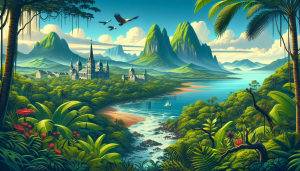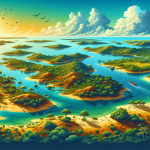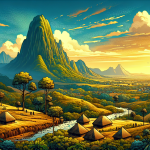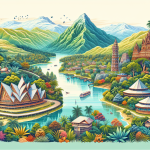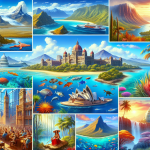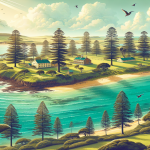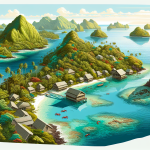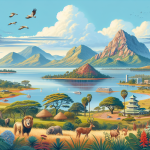Exploring the Hidden Gem of Central Africa: Equatorial Guinea
Equatorial Guinea, a small yet captivating country on the western coast of Central Africa, often goes unnoticed on the global travel radar. Nestled between Cameroon and Gabon, this intriguing nation offers a unique blend of cultural richness, breathtaking natural beauty, and a fascinating history. From its pristine beaches and lush rainforests to its vibrant cities and diverse cultural heritage, Equatorial Guinea promises an unforgettable journey for adventurous travelers. In this comprehensive guide, we will delve into the many facets of Equatorial Guinea, uncovering its hidden treasures and highlighting the must-visit destinations, local experiences, and practical travel tips to make the most of your exploration. Whether you’re an intrepid explorer seeking off-the-beaten-path adventures or a cultural enthusiast eager to immerse yourself in the traditions of a lesser-known land, Equatorial Guinea is a destination that will leave you enchanted and inspired.
Discovering the Natural Wonders of Equatorial Guinea
Equatorial Guinea boasts a diverse range of natural landscapes, from pristine beaches along its coastline to dense rainforests teeming with wildlife. The country’s unique geography provides a haven for nature enthusiasts and adventure seekers alike.
Pristine Beaches and Coastal Beauty
The coastline of Equatorial Guinea is dotted with stunning beaches that offer a perfect blend of relaxation and adventure. Malabo, the capital city located on Bioko Island, is home to some of the most beautiful beaches in the country. Arena Blanca, a white sandy beach, is a popular destination for both locals and tourists. The turquoise waters and serene ambiance make it an ideal spot for swimming, sunbathing, and beachcombing.
Another must-visit beach is Ureca, known for its rugged beauty and dramatic cliffs. Located on the southern tip of Bioko Island, Ureca is a haven for nature lovers. The beach is surrounded by lush rainforests and is a great starting point for hiking adventures. Visitors can explore the nearby waterfalls and encounter a variety of wildlife, including monkeys and exotic birds.
Lush Rainforests and Biodiversity
Equatorial Guinea is home to some of the most biodiverse rainforests in Africa. The Monte Alen National Park, located on the mainland, is a prime example of the country’s rich natural heritage. This sprawling park covers over 2,000 square kilometers and is a sanctuary for numerous species of flora and fauna. Hiking through the dense forest trails, visitors can spot elephants, gorillas, chimpanzees, and a myriad of bird species.
For a more immersive rainforest experience, head to the Annobón Island, a remote and less-visited part of Equatorial Guinea. The island’s lush landscapes are characterized by volcanic peaks, crater lakes, and dense forests. Annobón’s isolation has allowed its unique ecosystem to thrive, making it a paradise for ecotourism and wildlife observation.
Cultural Richness and Heritage of Equatorial Guinea
Equatorial Guinea’s cultural heritage is a fascinating tapestry woven from the diverse ethnic groups that call the country home. The blend of African traditions, colonial influences, and modern developments creates a vibrant cultural landscape.
Traditional Festivals and Celebrations
One of the best ways to experience the cultural richness of Equatorial Guinea is by participating in its traditional festivals and celebrations. The Bubi people, one of the indigenous ethnic groups, celebrate the Bubi New Year with great fervor. This festival, known as “Año Nuevo Bubi,” is marked by traditional dances, music, and rituals that showcase the community’s deep connection to their ancestral roots.
Another significant cultural event is the Fandango Festival, celebrated by the Fang people. This lively festival features energetic dances, colorful costumes, and rhythmic drumming. It is a celebration of unity and community, and visitors are often welcomed to join in the festivities and experience the warmth and hospitality of the Fang people.
Historical and Architectural Treasures
Equatorial Guinea’s colonial past is reflected in its historical and architectural landmarks. Malabo Cathedral, also known as Catedral de Santa Isabel, is a striking example of Spanish colonial architecture. The cathedral’s iconic twin spires and intricate façade make it a prominent landmark in Malabo. Visitors can explore the interior, which features beautiful stained glass windows and religious artwork.
Another historical site worth visiting is the Bata Cathedral, located in the city of Bata on the mainland. This grand cathedral, built in the early 20th century, showcases a blend of European and African architectural styles. It stands as a testament to the country’s colonial history and serves as a place of worship for the local community.
Practical Travel Tips for Equatorial Guinea
Traveling to Equatorial Guinea requires some preparation and awareness of the local customs and regulations. Here are some practical tips to ensure a smooth and enjoyable trip.
Visa and Entry Requirements
Visitors to Equatorial Guinea are required to obtain a visa before arrival. It is advisable to check with the nearest Equatorial Guinean embassy or consulate for the most up-to-date visa requirements and application procedures. Additionally, travelers should ensure that their passport is valid for at least six months from the date of entry.
Health and Safety Precautions
Equatorial Guinea is a tropical country, and travelers should take necessary health precautions. It is recommended to get vaccinated against common tropical diseases such as yellow fever, malaria, and typhoid. Carrying a basic first-aid kit and mosquito repellent is also advisable.
Safety is an important consideration while traveling in Equatorial Guinea. While the country is generally safe for tourists, it is wise to exercise caution and be aware of your surroundings. Avoid traveling alone at night and keep your belongings secure.
Currency and Language
The official currency of Equatorial Guinea is the Central African CFA franc (XAF). It is advisable to carry sufficient cash, as credit card facilities may be limited, especially in remote areas. Currency exchange services are available in major cities, and ATMs can be found in Malabo and Bata.
Spanish is the official language of Equatorial Guinea, but French and Portuguese are also widely spoken. Learning a few basic phrases in Spanish can be helpful for communication, especially in rural areas where English may not be understood.
Exploring Equatorial Guinea’s Unique Attractions
Equatorial Guinea is brimming with unique attractions that cater to a variety of interests. Whether you’re a history buff, nature enthusiast, or cultural explorer, there’s something for everyone in this captivating country.
Pico Basile National Park
Pico Basile National Park, located on Bioko Island, is home to the highest peak in Equatorial Guinea, Pico Basile. The park offers a range of hiking trails that lead through lush forests and offer breathtaking views of the surrounding landscapes. The summit of Pico Basile provides a panoramic vista of the island and the Gulf of Guinea, making it a rewarding destination for trekkers and nature lovers.
The Malabo Promenade
The Malabo Promenade is a scenic waterfront area that offers a relaxing escape from the bustling city. Visitors can take leisurely strolls along the promenade, enjoying views of the ocean and the distant mountains. The area is lined with cafes and restaurants where you can savor local cuisine and fresh seafood. The promenade is particularly enchanting during sunset, when the sky is painted in hues of orange and pink.
The City of Bata
Bata, the largest city on the mainland, is a vibrant hub of activity and culture. The city’s bustling markets, such as the Central Market of Bata, offer a glimpse into the local way of life. Here, you can find a variety of goods, from fresh produce and spices to traditional crafts and clothing. Bata is also known for its lively nightlife, with numerous bars and clubs where you can experience the local music and dance scene.
Embracing the Local Cuisine
Equatorial Guinea’s cuisine is a delightful fusion of African, Spanish, and Portuguese influences. The country’s coastal location ensures an abundance of fresh seafood, while its fertile lands provide a variety of fruits and vegetables.
Must-Try Dishes
One of the most popular dishes in Equatorial Guinea is “pescado con tres salsas,” a fish dish served with three different sauces. The fish is typically grilled or fried and accompanied by a trio of flavorful sauces made from tomatoes, onions, and peppers.
Another traditional dish is “sopa de pescado,” a hearty fish soup that is often enjoyed as a main course. The soup is made with fresh fish, vegetables, and spices, resulting in a rich and aromatic broth.
For a taste of the local street food, try “malamba,” a traditional snack made from roasted plantains. Malamba is often served with a spicy sauce and is a favorite among locals for its delicious and satisfying flavor.
Dining Etiquette
When dining in Equatorial Guinea, it is customary to greet your hosts and fellow diners before starting a meal. Sharing food is a common practice, and it is considered polite to offer a portion of your dish to others.
In more formal settings, it is advisable to wait for the host to invite you to begin eating. Using your right hand for eating and passing food is a sign of respect, as the left hand is considered unclean in many African cultures.
Adventure Activities in Equatorial Guinea
For those seeking adventure and adrenaline, Equatorial Guinea offers a range of thrilling activities that allow you to explore its natural beauty and rugged landscapes.
Hiking and Trekking
Equatorial Guinea’s diverse terrain makes it a paradise for hikers and trekkers. The Monte Alen National Park is a popular destination for trekking, with trails that wind through dense forests and offer opportunities to spot wildlife. The park’s Moca Valley is particularly scenic, with its rolling hills, waterfalls, and picturesque villages.
For a more challenging trek, consider hiking to the summit of Pico Basile. The ascent is demanding, but the panoramic views from the top are well worth the effort. Along the way, you’ll pass through different ecological zones, from tropical rainforests to alpine meadows.
Water Sports and Diving
The coastal waters of Equatorial Guinea are ideal for water sports and diving. The clear, warm waters of the Gulf of Guinea are teeming with marine life, making it a great destination for snorkeling and scuba diving. The island of Corisco is a popular spot for diving, with its vibrant coral reefs and diverse marine species.
For those who prefer a more relaxed water activity, kayaking along the coastline or in the mangrove forests is a great way to explore the natural beauty of Equatorial Guinea. The calm waters and scenic surroundings make for a peaceful and enjoyable experience.
Conclusion
Equatorial Guinea may be a small country, but it is rich in natural beauty, cultural heritage, and unique experiences. From its pristine beaches and lush rainforests to its vibrant cities and diverse cuisine, Equatorial Guinea offers something for every traveler. Whether you’re seeking adventure, relaxation, or cultural immersion, this hidden gem of Central Africa is sure to captivate and inspire you. So pack your bags and get ready to explore the wonders of Equatorial Guinea – a destination that promises unforgettable memories and a journey of discovery.
For more information on travel destinations and tips, check out this comprehensive travel guide by Lonely Planet.
